Effects of CNTs/PVA on Concrete Performance: Strength, Drying Shrinkage, and Microstructure
Abstract
1. Introduction
2. Materials and Methods
2.1. Materials
2.2. Sample Preparation
- (1)
- Dissolve PVA in water at 95 °C and stir it into a uniform colloid using a magnetic stirrer (approximately 30 min).
- (2)
- Add CNTs to the PVA sol and ultrasonically disperse the carbon nanotubes at 60 °C using an ultrasonic device (1.5 h) to form a uniformly dispersed CNTs/PVA solution.
- (3)
- Place cement, sand, and aggregates into a mixer and dry mix for 1 min.
- (4)
- Add the CNTs/PVA solution, remaining water, water-reducing agent, and defoamer into the mixer and stir for 5 min.
- (5)
- After mixing, pour the concrete into oil-coated molds and compact it on a vibrating table.
- (6)
- Level the surface of the concrete in the molds, cover them with wet cloth for curing, demold after 24 h, and then place the specimens in water for further curing.
2.3. Performance Testing
3. Results
3.1. Mechanical Properties
3.2. Drying Shrinkage
3.3. Capillary Water Absorption
3.4. Microstructure
4. Discussion
5. Conclusions
- (1)
- Scanning electron microscopy (SEM) tests indicated that an appropriate amount of CNTs and PVA was uniformly dispersed in the concrete and formed a three-dimensional linear interpenetrating network. This network refined pores, bridged cracks, and improved the micro- and meso-scale properties of the concrete.
- (2)
- The CNT/PVA synergy significantly enhanced the mechanical properties: with 1.0% PVA, (1) 0.5% CNTs elevated the flexural strength by 12% (p < 0.01 via Tukey’s test), and (2) 0.3% CNTs boosted the compressive strength by 15% (p < 0.001) versus plain concrete controls, demonstrating a dose-dependent reinforcement.
- (3)
- The drying shrinkage rate of CNTs and PVA composite-modified concrete increased with age, but it remained essentially unchanged after the curing age exceeded 180 days. The CNTs and PVA could reduce the drying shrinkage rate of concrete. When the CNTs content was 0.5%, the drying shrinkage rates at 7, 28, 180, and 360 days decreased by 76%, 34%, 22%, and 21%, respectively.
- (4)
- The CNT/PVA modification (1.0% PVA + 0.5% CNTs) achieved a 26% reduction in the capillary absorption coefficient versus the control concrete (p < 0.01), which demonstrated enhanced water resistance.
- (5)
- The addition of PVA alone could reduce the early drying shrinkage of concrete, but the shrinkage rate increased rapidly. At 360 days of age, the drying shrinkage rate of the PVA-modified concrete was nearly the same as that of ordinary concrete.
- (6)
- When PVA was used alone or when the CNTs content was excessive (e.g., 1.0%), the improvement in the 28-day strength of concrete was not significant. With PVA alone or a composite mix of 1.0% CNTs, the strength of the concrete increased by only 3–6%.
Author Contributions
Funding
Institutional Review Board Statement
Informed Consent Statement
Data Availability Statement
Conflicts of Interest
References
- Shaban, W.M.; Shen, S.-L.; Ashour, A.G.; Zhou, A.; Elbaz, K. Physics-based self-adaptive algorithm for estimating the long-term performance of concrete shrinkage. Eng. Appl. Artif. Intell. 2025, 142, 109945. [Google Scholar] [CrossRef]
- Aili, A.; Vandamme, M.; Torrenti, J.-M.; Masson, B. A viscoelastic poromechanical model for shrinkage and creep of concrete. Cem. Concr. Res. 2020, 129, 105970. [Google Scholar] [CrossRef]
- Jafarifar, N.; Pilakoutas, K.; Bennett, T. Moisture transport and drying shrinkage properties of steel–fibre-reinforced-concrete. Constr. Build. Mater. 2014, 73, 41–50. [Google Scholar] [CrossRef]
- Yousefieh, N.; Joshaghani, A.; Hajibandeh, E.; Shekarchi, M. Influence of fibers on drying shrinkage in restrained concrete. Constr. Build. Mater. 2017, 148, 833–845. [Google Scholar] [CrossRef]
- Kim, D.J.; Kim, S.H.; Choi, W.C. Characteristics of Restrained Drying Shrinkage on Arched Steel Fiber-Reinforced Concrete. Appl. Sci. 2021, 11, 7537. [Google Scholar] [CrossRef]
- Li, G.Y.; Wang, P.M.; Zhao, X. Mechanical behavior and microstructure of cement composites incorporating surface-treated multi-walled carbon nanotubes. Carbon 2005, 43, 1239–1245. [Google Scholar] [CrossRef]
- Mohsen, M.O.; Alansari, M.; Taha, R.; Senouci, A.; Abutaqa, A. Impact of CNTs’ treatment, length and weight fraction on ordinary concrete mechanical properties. Constr. Build. Mater. 2020, 264, 120698. [Google Scholar] [CrossRef]
- Jung, M.; Lee, Y.S.; Hong, S.G.; Moon, J. Carbon nanotubes (CNTs) in ultra-high performance concrete (UHPC): Dispersion, mechanical properties, and electromagnetic interference (EMI) shielding effectiveness (SE). Cem. Concr. Res. 2020, 131, 106017. [Google Scholar] [CrossRef]
- Xing, G.; Xu, Y.; Huang, J.; Lu, Y.; Miao, P.; Chindasiriphan, P.; Jongvivatsakul, P.; Ma, K. Research on the mechanical properties of steel fibers reinforced carbon nanotubes concrete. Constr. Build. Mater. 2023, 392, 131880. [Google Scholar] [CrossRef]
- Woo, J.-S.; Jin, A.-H.; Yun, H.-D.; Yu, J.; Bae, J.H.; Kim, S.-W.; Seo, S.-Y.; Lee, G.-C.; Hong, S.; Kim, K.-S.; et al. Effects of ultrasonication on electrical and self-sensing properties for fiber-reinforced cementitious composites containing MWCNTs. J. Mater. Res. Technol. 2025, 34, 1509–1528. [Google Scholar] [CrossRef]
- Yazdanbakhsh, A.; Grasley, Z. The theoretical maximum achievable dispersion of nanoinclusions in cement paste. Cem. Concr. Res. 2012, 42, 798–804. [Google Scholar] [CrossRef]
- Lee, S.Y.; Nguyen, V.T.; Moon, J.-H.; Kim, D.J. Simulation-based analysis of impact of CNT dispersion on hydration of cement paste. J. Build. Eng. 2024, 98, 111116. [Google Scholar] [CrossRef]
- Konsta-Gdoutos, M.S.; Metaxa, Z.S.; Shah, S.P. Highly dispersed carbon nanotube reinforced cement based materials. Cem. Concr. Res. 2010, 40, 1052–1059. [Google Scholar] [CrossRef]
- Soliman, E.M.; Kandil, U.F.; Taha, M.M.R. The significance of carbon nanotubes on styrene butadiene rubber (SBR) and SBR modified mortar. Mater. Struct. 2012, 45, 803–816. [Google Scholar] [CrossRef]
- Spitalsky, Z.; Tasis, D.; Papagelis, K.; Galiotis, C. Carbon nanotube–polymer composites: Chemistry, processing, mechanical and electrical properties. Prog. Polym. Sci. 2010, 35, 357–401. [Google Scholar] [CrossRef]
- Elbakyan, L.; Zaporotskova, I. Polypropylene Modified with Carbon Nanomaterials: Structure, Properties and Application (A Review). Polymers 2025, 17, 517. [Google Scholar] [CrossRef]
- Zhou, X.; Zhu, Y.; Liang, J.; Yu, S. New Fabrication and Mechanical Properties of Styrene-Butadiene Rubber/Carbon Nanotubes Nanocomposite. J. Mater. Sci. Technol. 2010, 26, 1127–1132. [Google Scholar] [CrossRef]
- Coleman, J.N.; Cadek, M.; Blake, R.; Nicolosi, V.; Ryan, K.P.; Belton, C.; Fonseca, A.; Nagy, J.B.; Gun’ko, Y.K.; Blau, W.J. High Performance Nanotube-Reinforced Plastics: Understanding the Mechanism of Strength Increase. Adv. Funct. Mater. 2004, 14, 791–798. [Google Scholar] [CrossRef]
- Ryan, K.P.; Cadek, M.; Nicolosi, V.; Blond, D.; Ruether, M.; Armstrong, G.; Swan, H.; Fonseca, A.; Nagy, J.B.; Maser, W.K.; et al. Carbon nanotubes for reinforcement of plastics? A case study with poly(vinyl alcohol). Compos. Sci. Technol. 2007, 67, 1640–1649. [Google Scholar] [CrossRef]
- Logakis, E.; Pissis, P.; Pospiech, D.; Korwitz, A.; Krause, B.; Reuter, U.; Pötschke, P. Low electrical percolation threshold in poly(ethylene terephthalate)/multi-walled carbon nanotube nanocomposites. Eur. Polym. J. 2010, 46, 928–936. [Google Scholar] [CrossRef]
- Xu, B.; Wang, R.; Zhou, K.; Zhou, X.; Xu, T.; Bian, Q. Research on the physical characteristics of a novel modified foamed cement slurry with non-foamed PVA material. Constr. Build. Mater. 2025, 459, 139710. [Google Scholar] [CrossRef]
- Fan, J. Mechanical Properties and Sensibility of CNT/PVA Hybrid Modified Cement Mortar. Ph.D. Thesis, Shantou University, Shantou, China, 2016. (In Chinese). [Google Scholar]
- Wang, Z.; Yu, J.; Li, G.; Zhang, M.; Leung, C.K.Y. Corrosion behavior of steel rebar embedded in hybrid CNTs-OH/polyvinyl alcohol modified concrete under accelerated chloride attack. Cem. Concr. Compos. 2019, 100, 120–129. [Google Scholar] [CrossRef]
- Abrahamsson, C.; Rissler, J.; Kåredal, M.; Hedmer, M.; Suchorzewski, J.; Prieto, M.; Chaudhari, O.A.; Gudmundsson, A.; Isaxon, C. Characterization of airborne dust emissions from three types of crushed multi-walled carbon nanotube-enhanced concretes. NanoImpact 2024, 34, 100500. [Google Scholar] [CrossRef]
- Wang, X.; Feng, D.; Meng, J.; Li, Q.; Wang, G.; Ai, X.; Cheng, P.; Tang, K.; Xie, N. Double percolation phenomenon of carbon nanotube/cement composites as piezoresistivity sensing elements with exposure to salt environment. Cem. Concr. Compos. 2024, 147, 105401. [Google Scholar] [CrossRef]
- Sun, J.; Qiao, G. Enhancement of the piezoresistive and mechanical properties of cement-based composites filled with CNTs/GO and nano-SiO2 sprayed steel fibers. Constr. Build. Mater. 2023, 385, 131463. [Google Scholar] [CrossRef]
- Reis, E.D.; Resende, H.F.; Christoforo, A.L.; Costa, R.M.; Gatuingt, F.; Poggiali, F.S.J.; Bezerra, A.C.S. Assessment of physical and mechanical properties of concrete with carbon nanotubes pre-dispersed in cement. J. Build. Eng. 2024, 89, 109255. [Google Scholar] [CrossRef]
- Wang, X.; Zhong, J. Revisiting the effects of carbon nanotube agglomerates in cement. Carbon 2025, 231, 119710. [Google Scholar] [CrossRef]
- Tafesse, M.; Kim, H.-K. The role of carbon nanotube on hydration kinetics and shrinkage of cement composite. Compos. Part B Eng. 2019, 169, 55–64. [Google Scholar] [CrossRef]
- Kim, G.M.; Yoon, H.N.; Lee, H.K. Autogenous shrinkage and electrical characteristics of cement pastes and mortars with carbon nanotube and carbon fiber. Constr. Build. Mater. 2018, 177, 428–435. [Google Scholar] [CrossRef]
- Song, C.; Hong, G.; Choi, S. Effect of dispersibility of carbon nanotubes by silica fume on material properties of cement mortars: Hydration, pore structure, mechanical properties, self-desiccation, and autogenous shrinkage. Constr. Build. Mater. 2020, 265, 120318. [Google Scholar] [CrossRef]
- Wang, X.; Zhong, J. Mitigating autogenous shrinkage of cement with carbon nanotube sponge. Cem. Concr. Compos. 2024, 150, 105571. [Google Scholar] [CrossRef]
- Li, Y.; Li, Y.; Li, H.; Lin, H. The role of carbon nanotubes to reduce autogenous shrinkage of cement paste at different ages. J. Build. Eng. 2023, 80, 107927. [Google Scholar] [CrossRef]
- Fan, J.; Deng, S.; Li, G.; Li, J.; Zhang, J. Synergistic effect of carbon nanotubes and polyvinyl alcohol on the mechanical performance and microstructure of cement mortar. Nanotechnol. Rev. 2024, 13, 20240028. [Google Scholar] [CrossRef]
- Güler, Ö.; Cacim, N.N.; Evin, E.; Yahia, I.S. The synergistic effect of CNTs-polymeric surfactant on the properties of concrete nanocomposites: Comparative study. J. Compos. Mater. 2021, 55, 1371–1384. [Google Scholar] [CrossRef]
- JGJ52-2006; Standard for Technical Requirements and Test Method of Sand and Crushed Stone (or Gravel) for Ordinary Concrete. Ministry of Construction of the People’s Republic of China: Beijing, China, 2006.
- GB/T 50081-2019; Standard for Test Methods of Concrete Physical and Mechanical Properties. China Architecture & Building Press: Beijing, China, 2019.
- GB/T 50082-2009; Standard for Test Methods of Long-Term Performance and Durability of Ordinary Concrete. China Architecture & Building Press: Beijing, China, 2009.
- Rennhofer, H.; Zanghellini, B. Dispersion State and Damage of Carbon Nanotubes and Carbon Nanofibers by Ultrasonic Dispersion: A Review. Nanomaterials 2021, 11, 1469. [Google Scholar] [CrossRef] [PubMed]
- Carriço, A.; Bogas, J.A.; Hawreen, A.; Guedes, M. Durability of multi-walled carbon nanotube reinforced concrete. Constr. Build. Mater. 2018, 164, 121–133. [Google Scholar] [CrossRef]
- Hawreen, A.; Bogas, J.A.; Dias, A.P.S. On the mechanical and shrinkage behavior of cement mortars reinforced with carbon nanotubes. Constr. Build. Mater. 2018, 168, 459–470. [Google Scholar] [CrossRef]
- Reis, E.D.; Gatuingt, F.; Poggiali, F.S.J.; Bezerra, A.C.S. Influence of carbon nanotubes and cement reduction on the bond strength of steel bars in concrete: An experimental investigation. Constr. Build. Mater. 2025, 461, 139940. [Google Scholar] [CrossRef]
- Shen, J.; Wang, Y.; Yu, Y.; Fu, P.; Zhang, M.; Qing, L.; Yang, R. Hybrid effects of carbon nanotubes and nano-rubber on the mechanical properties and microstructure of oil well cement paste cured at different temperatures: Experimental studies and a micromechanical model. Cem. Concr. Compos. 2025, 156, 105842. [Google Scholar] [CrossRef]
- Ashwini, B. Comparison of mechanical properties of concrete incorporated with Multiwalled Carbon nanotube and partial replacement of cement with flyash. Mater. Today Proc. 2023, in press. [Google Scholar] [CrossRef]
- Kim, S.; Piao, R.; Lee, S.K.; Oh, T.; Chun, B.; Jeong, J.-W.; Lee, H.-J.; Yoo, D.-Y. Thermoelectric cement-based composites containing carbon nanotubes (CNTs): Effects of water-to-cement ratio and CNT dosage. Case Stud. Constr. Mater. 2024, 21, e03861. [Google Scholar] [CrossRef]
- Gao, F.-F.; Duan, S.-Y.; Wang, W.-D.; Shi, Y.-L. Mechanism of MWCNT on the performance of concrete from the perspective of thermal stability. Constr. Build. Mater. 2024, 455, 139120. [Google Scholar] [CrossRef]
- Mehta, P.K.; Monteiro, P.J.M. Concrete: Microstructure, Properties, and Materials, 3rd ed.; MeGraw Hill: New York, NY, USA, 2006. [Google Scholar]
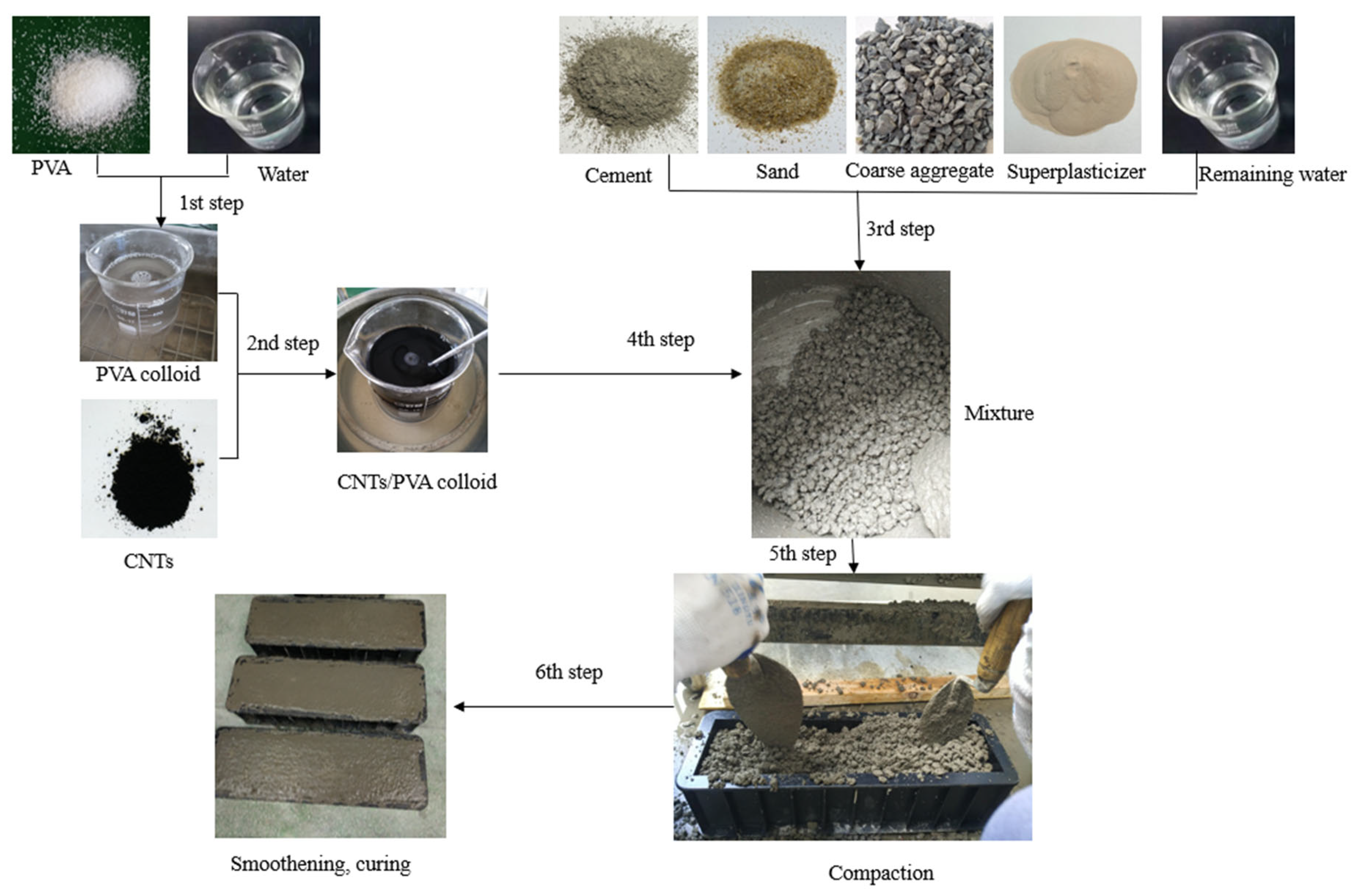
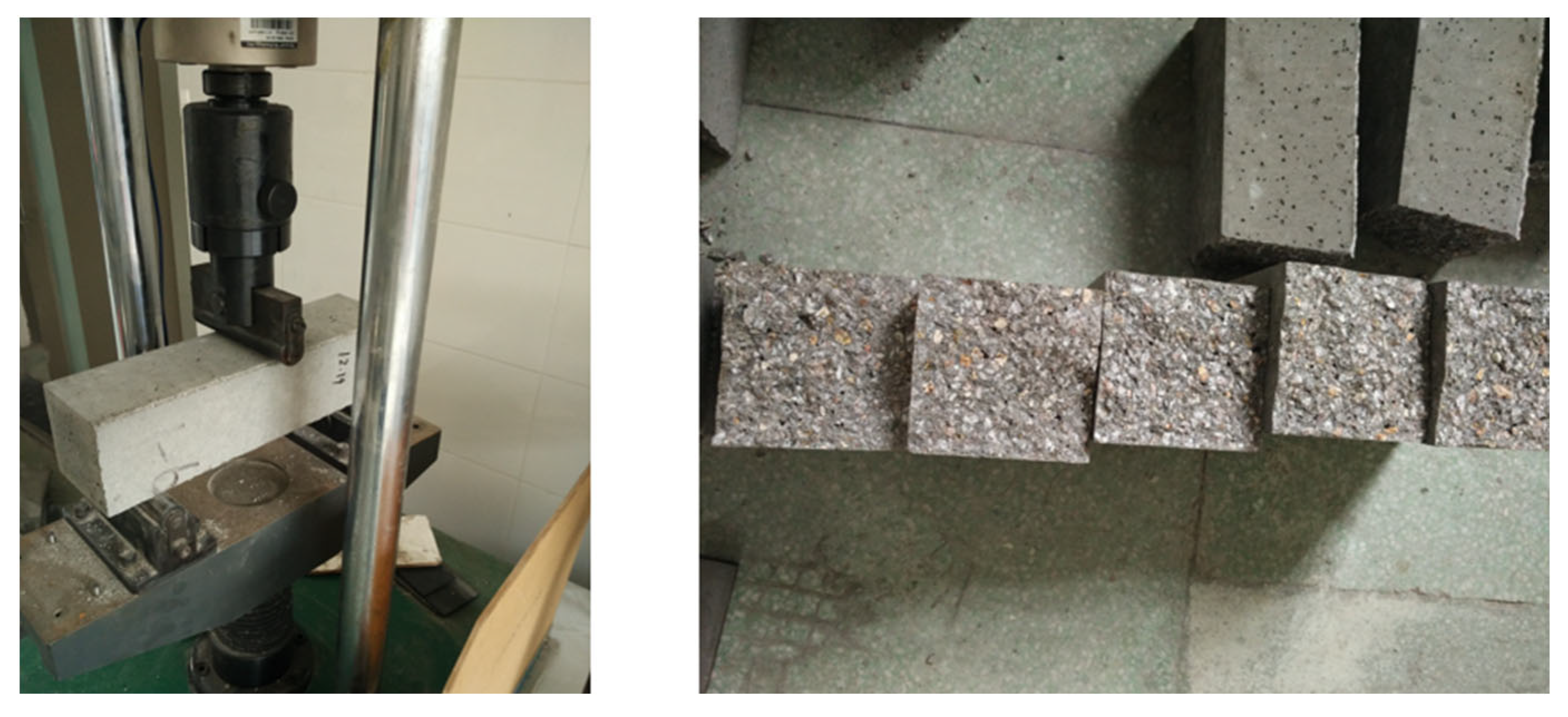
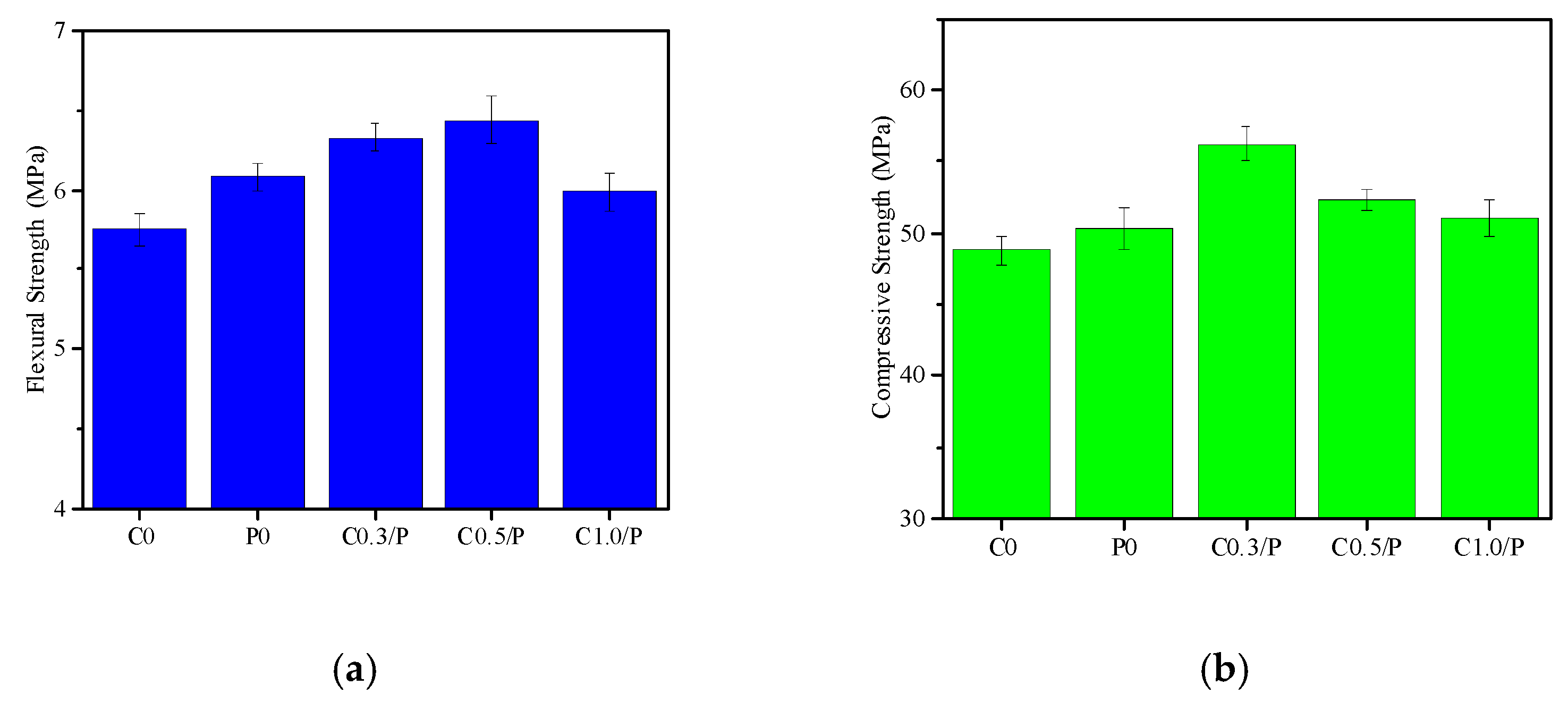
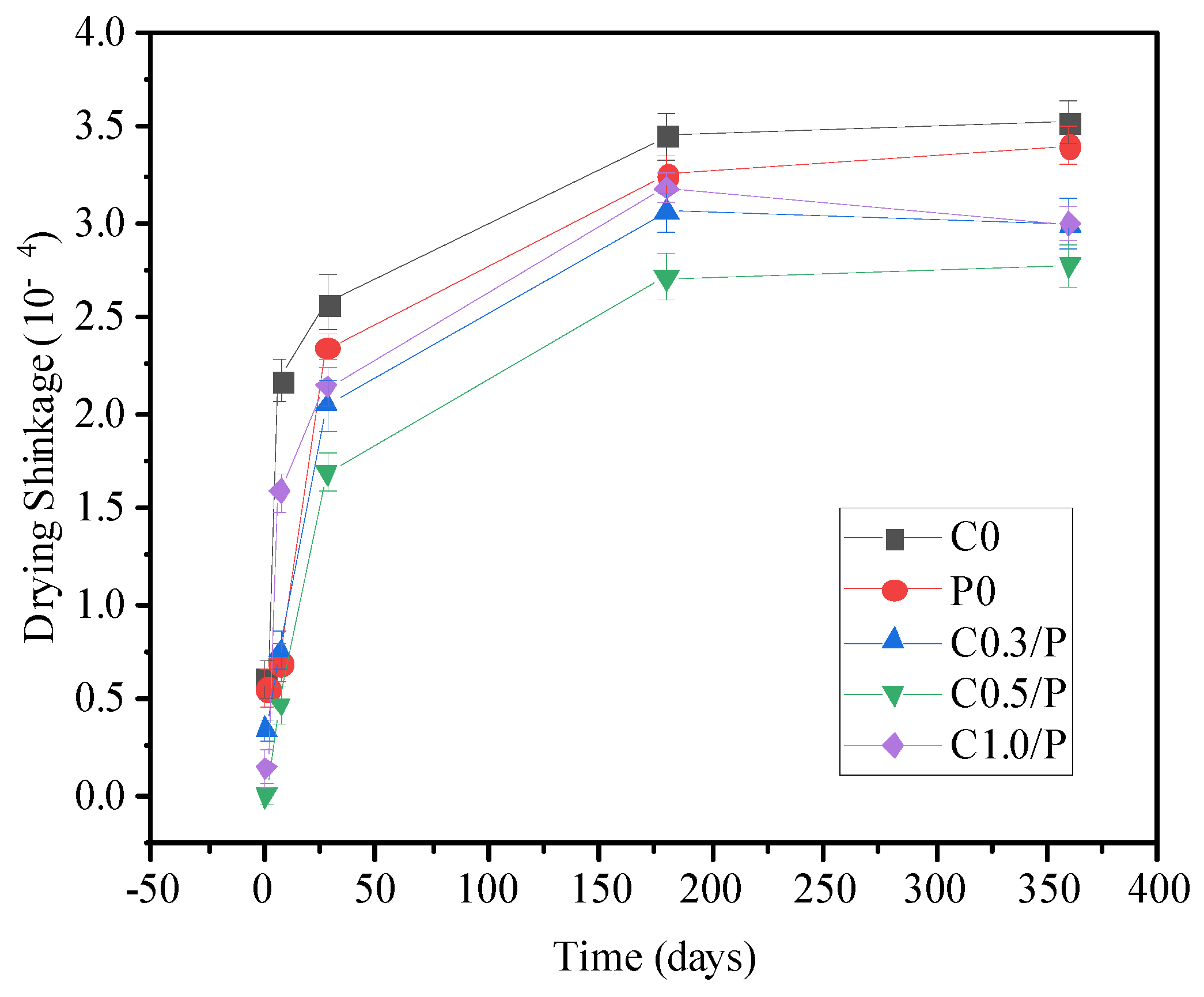
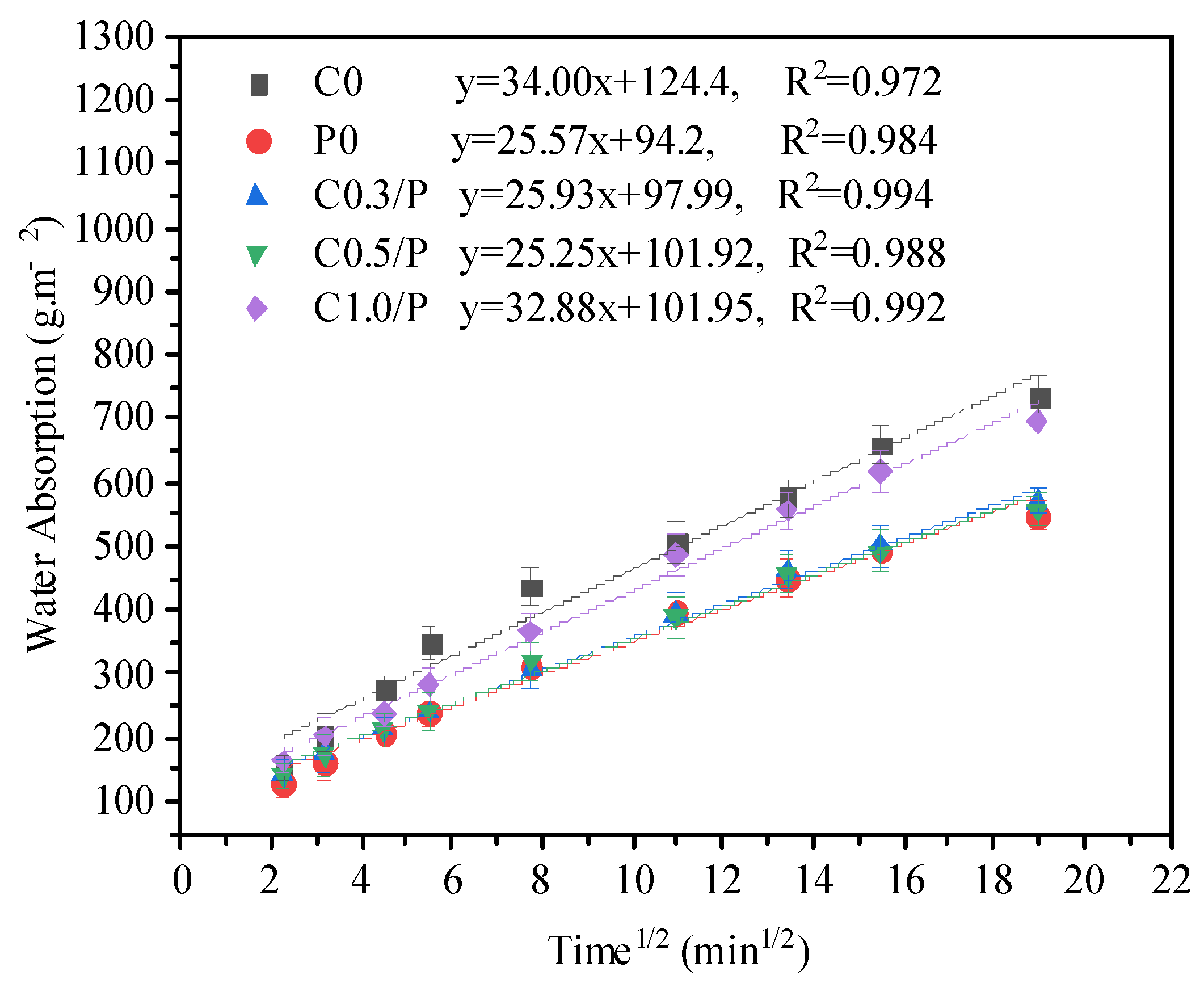
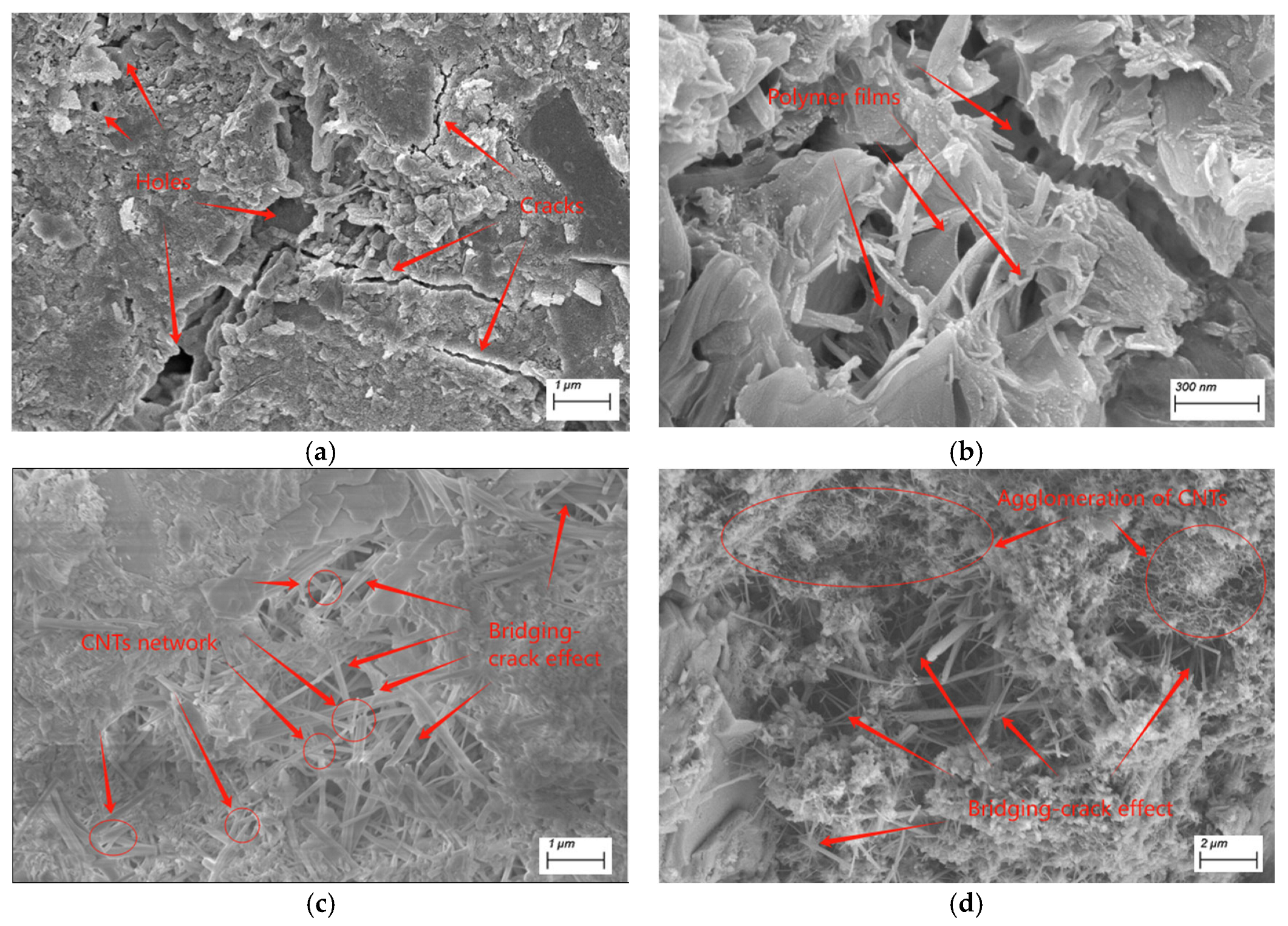
| Molecular Weight/(Mw) | Degree of Hydrolysis/(mole%) | pH | Volatile Content/(%) | Ash Content/(%) |
|---|---|---|---|---|
| 105,000 | 97 | 5–7 | 5.0 | 0.7 |
| Diameter/(nm) | Length/(µm) | Purity/(wt%) | Special Surface Area/(m2/g) | True Density/(g/cm3) | -OH Content/(wt%) |
|---|---|---|---|---|---|
| 10–30 | 30–50 | >90 | >230 | 2.1 | 5.58 |
| Cement/(kg/m3) | Water/(kg/m3) | Sand/(kg/m3) | Gravel/(kg/m3) | PVA/(%) | CNTs/(%) | Superplasticizer/(%) | |
|---|---|---|---|---|---|---|---|
| C0 | 380 | 171 | 593 | 1186 | 0 | 0 | 0.2 |
| P0 | 380 | 171 | 593 | 1186 | 1 | 0 | 0.4 |
| C0.3/P | 380 | 171 | 593 | 1186 | 1 | 0.3 | 0.6 |
| C0.5/P | 380 | 171 | 593 | 1186 | 1 | 0.5 | 0.8 |
| C1.0/P | 380 | 171 | 593 | 1186 | 1 | 1.0 | 1.0 |
Disclaimer/Publisher’s Note: The statements, opinions and data contained in all publications are solely those of the individual author(s) and contributor(s) and not of MDPI and/or the editor(s). MDPI and/or the editor(s) disclaim responsibility for any injury to people or property resulting from any ideas, methods, instructions or products referred to in the content. |
© 2025 by the authors. Licensee MDPI, Basel, Switzerland. This article is an open access article distributed under the terms and conditions of the Creative Commons Attribution (CC BY) license (https://creativecommons.org/licenses/by/4.0/).
Share and Cite
Lu, S.; Zuo, T.; Wang, Z.; Yan, S. Effects of CNTs/PVA on Concrete Performance: Strength, Drying Shrinkage, and Microstructure. Materials 2025, 18, 2535. https://doi.org/10.3390/ma18112535
Lu S, Zuo T, Wang Z, Yan S. Effects of CNTs/PVA on Concrete Performance: Strength, Drying Shrinkage, and Microstructure. Materials. 2025; 18(11):2535. https://doi.org/10.3390/ma18112535
Chicago/Turabian StyleLu, Shengliang, Ting Zuo, Zhongkun Wang, and Shuang Yan. 2025. "Effects of CNTs/PVA on Concrete Performance: Strength, Drying Shrinkage, and Microstructure" Materials 18, no. 11: 2535. https://doi.org/10.3390/ma18112535
APA StyleLu, S., Zuo, T., Wang, Z., & Yan, S. (2025). Effects of CNTs/PVA on Concrete Performance: Strength, Drying Shrinkage, and Microstructure. Materials, 18(11), 2535. https://doi.org/10.3390/ma18112535





